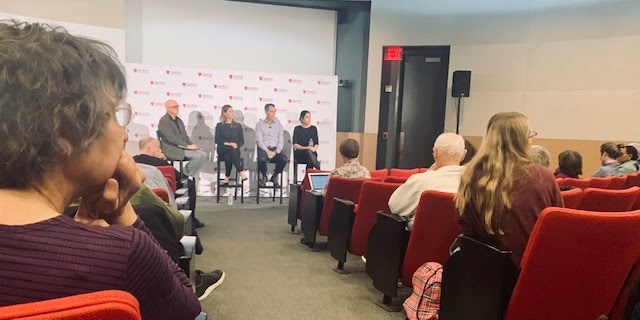Both the medical community and policymakers need to step up to address the problem of gun violence, argued a panel of experts in emergency medicine, medical law and health policy at a public forum hosted by Stanford Medicine on Tuesday.
The panel discussed issues including doctor-patient transparency, self-inflicted firearm injuries, public preparedness and mental health.
“Years ago, we as doctors were told that we should stay in our lanes, be quiet about legislation and just treat our patients,” said Kathy Staat, a clinical assistant professor of emergency medicine. “But now we realize that this is our lane, that it affects our patients.”
She believes that one of the key strategies to reducing gun violence or firearm-related injuries is to increase the transparency between doctors and patients.
“If someone indicates [thoughts of harming themselves or others] during a medical visit, we ask if they have a gun at home,” Staat said.
However, she said, some states are trying to eliminate the ability for patients and doctors to have this conversation.
Staat believes these types of gag laws could be detrimental to patients.
On the medical side, law and medicine professor David Studdert emphasized the importance of reducing the risk of gun-related injuries.
“We need to try to understand the mindset of gun owners,” Studdert said.
With regards to self-harm or self-inflicted injuries, Studdert said that firearms have a much higher fatality than other common mechanisms of self-harm such as overdosing on medication.
Staat agreed, saying that “gunshot wounds are far more likely to result in death or severe disability.”
One organization working to reduce the severity of gun injuries is Stop the Bleed, which trains people to help in cases of severe bleeding before emergency medical personnel arrive. The first five minutes after a patient is shot are critical because any life-threatening bleeding needs to be stopped during that time in order for a patient to survive, Staat said. However, it often takes emergency response teams longer than five minutes to arrive, so organizations have started to prepare gun violence kits in public places, complete with gauze and tourniquets, to increase the chance of survival for victims.
Taking care of a survivor’s mental and emotional well-being is just as important as ensuring their physical health, assistant professor of medicine Maya Rossin-Slater added.
“It’s important to intervene with mental health resources sooner rather than later,” she said.
Survivors and families of survivors may not realize the full extent of the consequences on their mental health, she said, and survivors can be at risk for self-harm and depression even years after the incident.
“One thing that surprises me is the length of time after the event that survivors are being prescribed antidepressants,” Rossin-Slater said. “We also have to think about the long-term effects of these medications on survivors as well.”
The lasting impacts of a shooting — or even the threat of one — are particularly pronounced on American schoolchildren, the panelists agreed. In schools across the country, children participate in active-shooter drills and are being taught how to hide in closets or barricade the doors of their classrooms. The act of practicing these drills can also have an effect on the mental health of children, even if they have never been exposed to gun violence directly, the panelists said.
At the end of the panel, the three speakers were asked how they resist becoming numb to frequent gun violence and shootings. Staat described her experience treating victims of gunshot wounds in the emergency room.
“I think of the phone calls being made and the people who aren’t calling back,” Staat said, referring to the moments of panic when family members are unsure of whether their loved ones are still alive. “After 13 years, I’m still not numb to it.”
Contact Sophia Nesamoney at nsophia ‘at’ stanford.edu.
